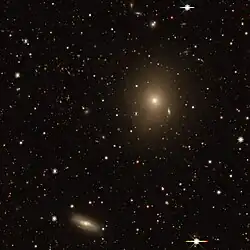| NGC 7004 | |
|---|---|
 NGC 7004 (bottom) and NGC 7002 (top) with legacy survey | |
| Observation data (J2000 epoch) | |
| Constellation | Indus |
| Right ascension | 21h 04m 02.2s[1] |
| Declination | −49° 06′ 51″[1] |
| Redshift | 0.025284 |
| Heliocentric radial velocity | 7580 km/s[1] |
| Distance | 329,462,000 ly |
| Apparent magnitude (V) | 13.8[1] |
| Characteristics | |
| Type | (R')SAB(s)0/a[1] |
| Size | ~166,981.78 ly |
| Apparent size (V) | 1.31× 0.44[1] |
| Other designations | |
| ESO 235-46, FAIR 938, PGC 66019[1] | |
NGC 7004 is a spiral galaxy[1] around 330 million light-years away from Earth in the constellation Indus.[2][1] NGC 7004 has an estimated diameter of 166,980 light-years.[1] NGC 7004 was discovered by astronomer John Herschel on October 2, 1834.[3] NGC 7004 is also part of a group of galaxies that contains the nearby galaxy NGC 7002.[4]
See also
References
- 1 2 3 4 5 6 7 8 9 10 "NED results for object NGC 7004". ned.ipac.caltech.edu. Retrieved 2017-04-23.
- ↑ Rojas, Sebastián García. "Galaxy NGC 7004 Deep Sky Objects Browser". DSO Browser. Archived from the original on 2017-05-24. Retrieved 2017-04-23.
- ↑ "New General Catalog Objects: NGC 7000 - 7049". cseligman.com. Retrieved 2017-04-15.
- ↑ "NGC 7004". SIMBAD. Centre de données astronomiques de Strasbourg. Retrieved 2017-06-22.
External links
 Media related to NGC 7004 at Wikimedia Commons
Media related to NGC 7004 at Wikimedia Commons- NGC 7004 on WikiSky: DSS2, SDSS, GALEX, IRAS, Hydrogen α, X-Ray, Astrophoto, Sky Map, Articles and images
This article is issued from Wikipedia. The text is licensed under Creative Commons - Attribution - Sharealike. Additional terms may apply for the media files.